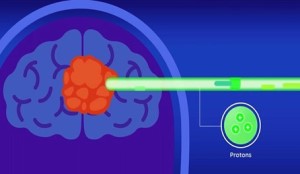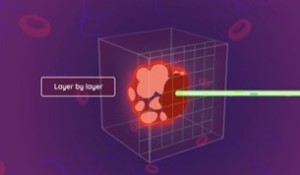Singapore, 3 October 2023 – The National Cancer Centre Singapore’s (NCCS) Goh Cheng Liang Proton Therapy Centre (GCLPTC) has treated 26 patients since starting operations in June 2023. For cancer patients, conventional radiotherapy remains the standard treatment, which is safe and effective for treating most solid cancers. Beyond conventional radiotherapy, proton therapy is an advanced type of radiotherapy suitable for certain cancers located close to vital organs and for treating some childhood cancers and tumours. Proton therapy demonstrates at least comparable clinical efficacy to conventional radiotherapy. Due to their physical properties, protons can target tumours more precisely, potentially reducing damage to nearby healthy tissues and organs and causing less treatment-related side effects.
“Conventional radiotherapy is an effective and safe treatment modality that remains the gold standard for treating most solid cancers. The unique qualities of proton therapy allow us to treat complex tumours in vulnerable areas near vital organs such as in the head and neck region, abdomen, spine and pelvis, with more precision and potentially lesser side effects. To ensure the best treatment outcomes, proton therapy will be offered to patients who can benefit the most from this new treatment modality,” said Dr Michael Wang, Chairman and Senior Consultant, Division of Radiation Oncology, NCCS.
Nine-year-old Reon Theodore Tan, the first child patient to undergo proton therapy at the GCLPTC was diagnosed with craniopharyngioma, a type of benign brain tumour in early 2023. Surgery followed by radiotherapy is the usual treatment for the condition if the tumour cannot be completely removed during surgery without damaging vital brain tissue. Reon underwent radiotherapy after surgery to treat the remaining tumour as well as surfaces that were in contact with the tumour. An important consideration when treating childhood tumours with radiotherapy are the late-onset side effects it can cause, which may occur months or even years after the child completes treatment. Proton therapy was recommended for Reon as it reduces overall exposure of the developing brain to radiation compared to x-ray-based radiotherapy, thereby mitigating the risk of late-onset side effects. Reon underwent 30 sessions of proton therapy from 31 July to 12 September. Today, life is almost back to normal for Reon who has returned to school.
“NCCS is committed to providing high quality, accessible cancer care to our population. Our clinicians and scientists continually seek and evaluate innovative cancer treatment options that are safe and beneficial for patients. Thanks to a generous S$50 million gift from the Goh Foundation, we are able to offer this advanced treatment to patients who need it, at the Goh Cheng Liang Proton Therapy Centre,” said Professor William Hwang, Chief Executive Officer, NCCS.
NCCS’ Division of Radiation Oncology offers a comprehensive range of radiotherapy techniques ranging from conventional radiotherapy to proton therapy at the GCLPTC. The GCLPTC occupies three basement floors of the new NCCS building and has four full 360-degrees rotating treatment gantries, a fixed beam room for research purposes and advanced imaging equipment. Proton therapy is planned and delivered by a multidisciplinary team consisting of radiation oncologists, medical physicists, radiation therapists and dosimetrists, who have undergone extensive specialist training overseas to acquire the necessary knowledge and skills to ensure the safe delivery of treatment.
Proton therapy is a non-standard treatment option and is thus not eligible for Government subsidies. However, proton therapy will remain eligible for MediShield Life and MediSave coverage, pegged at existing limits of its conventional radiation therapy treatment, for a specified list of medical conditions approved by the Ministry of Health (MOH) for proton therapy. Eligible patients who are considering proton therapy will be financially counselled on the estimated costs of treatment.
-END-
Annex
Proton therapy at the Goh Cheng Liang Proton Therapy Centre (GCLPTC)
Supported by a S$50 million gift from the Goh Foundation, the GCLPTC started operations in June 2023. Proton therapy is a type of advanced radiation treatment that targets cancer cells using positively charged subatomic particles called protons. The unique physical properties of protons enable tumours to be targeted more precisely. This potentially results in less damage to nearby healthy tissues and organs, and therefore less treatment-related side effects.

| 
|
Proton therapy precisely targets the tumour and stops at a limited depth, resulting in lesser damage to nearby healthy tissues and organs, and fewer side effects.
| The proton beam is delivered in very small ‘spots’ layer by layer, to treat complex shaped tumours and reduce radiation to nearby normal tissues.
|
Proton therapy at NCCS may be recommended for the following conditions on the current MOH-approved list of indications:
- Brain Tumours
- Head and Neck Cancers
- Digestive Tract Cancers
- Bone and Soft Tissue Cancers
- Prostate Cancer
- Lymphoma
- Certain Childhood Cancers
Note: Refer to MOH website for full list of indications.
A proton therapy treatment gantry at the Goh Cheng Liang Proton Therapy Centre
Goh Cheng Liang Proton Therapy Centre by Numbers:
- Over 2,000 sqm of floor space
- 4 full 360 degrees rotating treatment gantries to accurately deliver protons to the tumour site
- Each gantry weighs 220 tonnes and 10m high
- 1 fixed beam room for research purposes
- 3 CT simulation rooms for pre-treatment planning
Treatment Planning
The planning and delivery of proton therapy is similar to conventional radiotherapy. As part of the planning process, patients undergo immobilisation with customised devices. A CT simulation scan is done to measure the patient’s body and precisely mark the treatment areas. If the proton plan is assessed to be a more suitable treatment option for the patient than the conventional radiation plan, proton treatment will be recommended.
Treatment Process
During proton treatment, the patient is positioned on a high precision robotic couch. Treatment rooms are equipped with imaging systems to precisely position the patient for accurate beam delivery. The gantry system delivers proton beams by rotating a nozzle around the patient, enabling treatment beams to be delivered from any angle to target tumours with pin-point accuracy, to a spot size as small as 1 mm across. For more information about proton therapy or the GCLPTC, please visit:
https://www.nccs.com.sg/patient-care/specialties-services/Pages/goh-cheng-liang-proton-therapy-centre.aspx
For media queries, please contact:
Ms Lo Sok Wan
Corporate Communications
National Cancer Centre Singapore
Email:
[email protected]
Ms Dharshini Subbiah
Corporate Communications
National Cancer Centre Singapore
Email:
[email protected]
About the National Cancer Centre Singapore
The National Cancer Centre Singapore (NCCS) is a leading national and regional tertiary cancer centre with specialists who are experts in treating cancer. In addition to offering holistic and multidisciplinary oncology care, our clinicians and scientists collaborate with local and international partners to conduct robust, cutting-edge clinical and translational research. To achieve its vision of being a global leading cancer centre, NCCS offers world-class care and shares its depth of experience and expertise by training local and overseas medical professionals.
To meet growing healthcare needs, the new NCCS building fully opened in 2023 with increased capacity and expanded facilities dedicated to cancer care, rehabilitation, research and education. To give patients the best treatment outcomes, advanced and innovative treatment such as proton therapy is offered at the new Goh Cheng Liang Proton Therapy Centre at NCCS.
